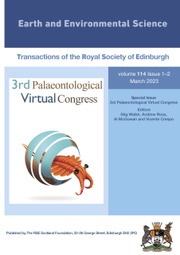Crossref Citations
This article has been cited by the following publications. This list is generated based on data provided by
Crossref.
Leeman, William P.
Annen, Catherine
and
Dufek, Josef
2008.
Snake River Plain – Yellowstone silicic volcanism: implications for magma genesis and magma fluxes.
Geological Society, London, Special Publications,
Vol. 304,
Issue. 1,
p.
235.
Zellmer, Georg F.
Fischer, Tobias P.
and
Chen, Chang-Hwa
2008.
Evolution, transfer and release of magmas and volcanic gases: An introduction.
Journal of Volcanology and Geothermal Research,
Vol. 178,
Issue. 4,
p.
v.
Shaw, S. E.
and
Flood, R. H.
2009.
Zircon Hf Isotopic Evidence for Mixing of Crustal and Silicic Mantle-derived Magmas in a Zoned Granite Pluton, Eastern Australia.
Journal of Petrology,
Vol. 50,
Issue. 1,
p.
147.
Schaltegger, Urs
Brack, Peter
Ovtcharova, Maria
Peytcheva, Irena
Schoene, Blair
Stracke, Andreas
Marocchi, Marta
and
Bargossi, Giuseppe M.
2009.
Zircon and titanite recording 1.5 million years of magma accretion, crystallization and initial cooling in a composite pluton (southern Adamello batholith, northern Italy).
Earth and Planetary Science Letters,
Vol. 286,
Issue. 1-2,
p.
208.
Danis, C. R.
Daczko, N. R.
Lackie, M. A.
and
Craven, S. J.
2010.
Retrograde metamorphism of the Wongwibinda Complex, New England Fold Belt and the implications of 2.5D subsurface geophysical structure for the metamorphic history.
Australian Journal of Earth Sciences,
Vol. 57,
Issue. 3,
p.
357.
Bachmann, Olivier
2010.
The petrologic evolution and pre-eruptive conditions of the rhyolitic Kos Plateau Tuff (Aegean arc).
Open Geosciences,
Vol. 2,
Issue. 3,
Peng, Peng
Guo, Jinghui
Zhai, Mingguo
and
Bleeker, Wouter
2010.
Paleoproterozoic gabbronoritic and granitic magmatism in the northern margin of the North China craton: Evidence of crust–mantle interaction.
Precambrian Research,
Vol. 183,
Issue. 3,
p.
635.
Menand, T.
Daniels, K. A.
and
Benghiat, P.
2010.
Dyke propagation and sill formation in a compressive tectonic environment.
Journal of Geophysical Research: Solid Earth,
Vol. 115,
Issue. B8,
Barboni, Mélanie
Bussy, François
and
Chiaradia, Massimo
2011.
Origin of Early Carboniferous pseudo‐adakites in northern Brittany (France) through massive amphibole fractionation from hydrous basalt.
Terra Nova,
Vol. 23,
Issue. 1,
p.
1.
Shaw, S.E.
Flood, R.H.
and
Pearson, N.J.
2011.
The New England Batholith of eastern Australia: Evidence of silicic magma mixing from zircon 176Hf/177Hf ratios.
Lithos,
Vol. 126,
Issue. 1-2,
p.
115.
Paterson, S. R.
Okaya, D.
Memeti, V.
Economos, R.
and
Miller, R. B.
2011.
Magma addition and flux calculations of incrementally constructed magma chambers in continental margin arcs: Combined field, geochronologic, and thermal modeling studies.
Geosphere,
Vol. 7,
Issue. 6,
p.
1439.
Annen, C.
2011.
Implications of incremental emplacement of magma bodies for magma differentiation, thermal aureole dimensions and plutonism–volcanism relationships.
Tectonophysics,
Vol. 500,
Issue. 1-4,
p.
3.
Miller, Calvin F.
Furbish, David J.
Walker, Barry A.
Claiborne, Lily L.
Koteas, G. Christopher
Bleick, Heather A.
and
Miller, Jonathan S.
2011.
Growth of plutons by incremental emplacement of sheets in crystal-rich host: Evidence from Miocene intrusions of the Colorado River region, Nevada, USA.
Tectonophysics,
Vol. 500,
Issue. 1-4,
p.
65.
Cebriá, J.M.
Martiny, B.M.
López-Ruiz, J.
and
Morán-Zenteno, D.J.
2011.
The Parícutin calc-alkaline lavas: New geochemical and petrogenetic modelling constraints on the crustal assimilation process.
Journal of Volcanology and Geothermal Research,
Vol. 201,
Issue. 1-4,
p.
113.
Menand, Thierry
2011.
Physical controls and depth of emplacement of igneous bodies: A review.
Tectonophysics,
Vol. 500,
Issue. 1-4,
p.
11.
Farina, Federico
Stevens, Gary
Dini, Andrea
and
Rocchi, Sergio
2012.
Peritectic phase entrainment and magma mixing in the late Miocene Elba Island laccolith–pluton–dyke complex (Italy).
Lithos,
Vol. 153,
Issue. ,
p.
243.
Pandit, Dinesh
and
Panigrahi, Mruganka Kumar
2012.
Comparative petrogenesis and tectonics of Paleoproterozoic Malanjkhand and Dongargarh granitoids, Central India.
Journal of Asian Earth Sciences,
Vol. 50,
Issue. ,
p.
14.
Luo, Biji
Zhang, Hongfei
and
Lü, Xinbiao
2012.
U–Pb zircon dating, geochemical and Sr–Nd–Hf isotopic compositions of Early Indosinian intrusive rocks in West Qinling, central China: petrogenesis and tectonic implications.
Contributions to Mineralogy and Petrology,
Vol. 164,
Issue. 4,
p.
551.
Qin, Jiang-Feng
Lai, Shao-Cong
and
Li, Yong-Fei
2013.
Multi-stage granitic magmatism during exhumation of subducted continental lithosphere: Evidence from the Wulong pluton, South Qinling.
Gondwana Research,
Vol. 24,
Issue. 3-4,
p.
1108.
Miles, A. J.
Graham, C. M.
Hawkesworth, C. J.
Gillespie, M. R.
and
Hinton, R. W.
2013.
Evidence for distinct stages of magma history recorded by the compositions of accessory apatite and zircon.
Contributions to Mineralogy and Petrology,
Vol. 166,
Issue. 1,
p.
1.


